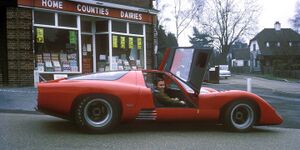MacGregor Cars
This article is incomplete because it is pending further input from participants, or it is a work-in-progress by one author. Please comment on this article's talk page to share your input, comments and questions. Note: To contribute to this article, you may need to seek help from the author(s) of this page. |
 | |
| Private | |
| Industry | Automotive |
| Predecessor | MacGregor Racing |
| Founded | June 2, 1975 in Sherbourne, Aswick |
| Founder | Glenn MacGregor |
| Headquarters | MacGregor Centre, Sherbourne , |
Area served | Astyria |
Key people | Glenn MacGregor Richard Stevanage David Valkenberg |
| Products | Sports cars |
Production output | 5,424 units[1] |
| Revenue | £1.562 billion[1] (2019) |
| £31.248 million[1] (2019) | |
| £40.842 million[1] (2019) | |
Number of employees | 4,568[1] (2020) |
| Divisions |
|
| Website | MacGregor.co.asw |
MacGregor Cars (Commonly referred to as just MacGregor) is an Aswickan designer and manufacturor of high-end sports cars. It was originally founded in 1970 as MacGregor Racing by Formula One racing driver Glenn MacGregor, in order to compete in the Astyrian Formula One racing series. MacGregor, however, quickly found that money could be made by design and sale of sports cars, using experience he and his designers gained in Formula One. Initially, the brand was marketed as the best way to experience high speed racing at a price lower than what was generally offered.
History
MacGregor Racing
In 1970, The Scotian Formula One driver Glenn MacGregor founded MacGregor Racing in a bid to continue his career in the sport after an injury led him to be unable to drive competitively. The team missed the first race of the season, and then failed to meet the expectations though it managed to finish in a respectable 4th place.[2] The following year, however, given more time to prepare, the team got back and won its first championship. Though for the next few years they by no means dominated, the team made good showings in the sport.
MacGregor Cars
In 1970, MacGregor decided to expand the company. He renamed MacGregor Racing to MacGregor Cars, and formed a division dedicated to Formula One to take the company's former place in the sport. In 1972, the first designs for a road legal race car were unveiled. The following year, the MacGregor Scotia entered production. A total of 1,500 were built in the next 10 years.
After this initial production run, the company began production of its successor: The MacGregor Aswick. Although this model performed slightly lower than expected, MacGregor still produced more units than they did of the Scotia.
in 1993, the company unveiled a special car. The MacGregor Grand Prix was a high end super car, with a production run of only 150 cars. Many considered this to be MacGregor's finest achievement, even surpassing their success in Formula One.
Facilities
Products
Current models
| Model | Type |
|---|---|
| 10S, 10C, 10LT | Sports |
| 11S, 11C, 11LT | Sports |
| Norris | Super |
| GT | Sports GT |
| Bat | Hybrid Sports |
Past models
| Model | Production run | No. produced |
|---|---|---|
| Scotia | 1973-1983 | 1,500 |
| Aswick | 1983-1993 | 2,500 |
| GP | 1993-2003 | 150 |
| Super GP | 2010-2012 | 400 |
| Mamba | 2003-2013 | 10,000 |
